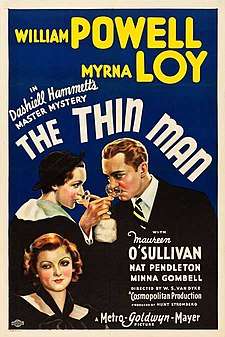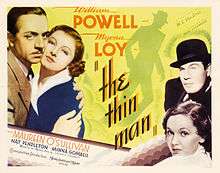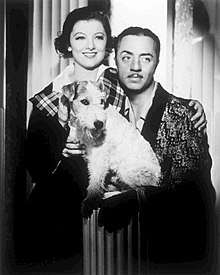The Thin Man (film)
The Thin Man is a 1934 American pre-Code comedy-mystery directed by W. S. Van Dyke and based on the novel of the same name by Dashiell Hammett. The film stars William Powell and Myrna Loy as Nick and Nora Charles, a leisure-class couple who enjoy copious drinking and flirtatious banter. Nick is a retired private detective who left his very successful career when he married Nora, a wealthy heiress accustomed to high society. Their wire-haired fox terrier Asta was played by canine actor Skippy. In 1997, the film was added to the United States National Film Registry having been deemed "culturally, historically, or aesthetically significant."
| The Thin Man | |
|---|---|
 Theatrical release poster | |
| Directed by | W. S. Van Dyke |
| Produced by | Hunt Stromberg |
| Screenplay by | |
| Based on | The Thin Man by Dashiell Hammett |
| Starring | |
| Music by | William Axt |
| Cinematography | James Wong Howe |
| Edited by | Robert Kern |
Production company | |
| Distributed by | Metro-Goldwyn-Mayer |
Release date |
|
Running time | 93 minutes |
| Country | United States |
| Language | English |
| Budget | $226,408 |
| Box office | $1,423,000 (worldwide est.) |
The film's screenplay was written by Albert Hackett and Frances Goodrich, a married couple. In 1934, the film was nominated for the Academy Award for Best Picture. The titular "Thin Man" is not Nick Charles, but the man Charles is initially hired to find – Clyde Wynant (part way through the film, Charles describes Wynant as a "thin man with white hair"). The "Thin Man" moniker was thought by many viewers to refer to Nick Charles and, after a time, it was used in the titles of sequels as if referring to Charles.
Plot

Nick Charles (William Powell), a retired detective, and his wealthy wife Nora (Myrna Loy), are visiting New York City to spend the Christmas holidays. There, Nick is pressed back into service by Dorothy Wynant (Maureen O'Sullivan), a young woman whose father, Clyde (Edward Ellis), was an old client of Nick's. Clyde, the title's "thin man", was supposed to be on a secret business trip and promised to be home before his daughter's wedding, but has mysteriously vanished. She convinces Nick to take the case, with the assistance of his socialite wife, eager to see him in action. What appears to be a missing person case turns into a murder case when Julia Wolf (Natalie Moorhead), Clyde's former secretary and love interest, is found dead, and evidence points to Clyde as the prime suspect. Dorothy refuses to believe that her father is guilty. The detective uncovers clues and eventually solves the mystery of the disappearance.
The murderer is exposed at a dinner party: A skeletonized body, found buried in Wynant's workshop during the investigation, had been assumed to be that of a "fat man" because it was wearing oversized clothing. However, Nick alleges that the clothes were planted to hide the true identity of the body, which still has shrapnel from an old war wound in one leg and belongs to a "thin man": the missing Wynant. Nick deduces that the real culprit murdered Clyde once Clyde found out he had been embezzling from him, then murdered Julia who knew about Clyde's murder, then also murdered Nunheim, who witnessed Julia's murder.
Nick reveals the identity of the killer as Wynant's attorney Herbert MacCauley (Porter Hall). Panicked, MacCauley tries to shoot Nick, but Nick punches him out.
Finally, Nick and Nora, as well as Dorothy and her new husband Tommy (Henry Wadsworth), celebrate as they take a train back to California.
Cast

|
|
Cast notes:
- Nat Pendleton reprised the role of Lt. Guild in 1939's Another Thin Man.[2]
Production
Screenplay
The film was based on the novel of the same name by Dashiell Hammett, released in January 1934. Hammett's novel drew on his experiences as a union-busting Pinkerton detective in Butte, Montana. Hammett based Nick and Nora's banter upon his rocky on-again, off-again relationship with playwright Lillian Hellman.[3]
MGM paid Hammett $21,000 for the screen rights to the novel. The screenplay was written by Albert Hackett and Frances Goodrich, who had been married for three years. Director W.S. Van Dyke encouraged them to use Hammett's writing as a basis only, and to concentrate on providing witty exchanges for Nick and Nora.
Casting
Van Dyke convinced MGM executives to let Powell and Loy portray the lead characters despite concerns that Powell was too old and strait-laced to play Nick Charles and that Loy had become typecast in exotic femme fatale roles.[4][5]
Skippy played Asta, the dog of Nick and Nora. Skippy was subsequently cast in two screwball comedy classics, The Awful Truth (1937) and Bringing Up Baby (1938).
Filming

–Film historian Andrew Sarris (1998)[6]
The film was shot with a budget of $226,408. For Powell's first scene in the film, Van Dyke told him to take the cocktail shaker, go to the bar and just walk through the scene while the crew checked lights and sound. Powell did it, throwing in some lines and business of his own. Suddenly he heard Van Dyke say, "That's it! Print it!" The director had decided to shoot the scene without Powell knowing it so that he would be as relaxed and natural as possible.
Van Dyke often did not bother with cover shots if he felt the scene was right on the first take, reasoning that actors "lose their fire" if they have to do something over and over. It was a lot of pressure on the actors, who often had to learn new lines and business immediately before shooting, without the luxury of retakes, but Loy credited much of the appeal of the film to Van Dyke's pacing and spontaneity. He paid the most attention to Powell and Loy's easy banter between takes and their obvious enjoyment of each other's company and worked it into the movie. The director often encouraged and incorporated improvisation and off-the-cuff details into the picture. In order to keep her entrance fresh and spontaneous, Van Dyke did not tell Loy about it until right before they shot it.
Powell loved working so much with Loy because of her naturalness, her professionalism, and her lack of any kind of "diva" temperament. Of her, Powell said:
When we did a scene together, we forgot about technique, camera angles, and microphones. We weren't acting. We were just two people in perfect harmony. Myrna, unlike some actresses who think only of themselves, has the happy faculty of being able to listen while the other fellow says his lines. She has the give and take of acting that brings out the best.
According to Loy, the actors were not allowed to interact between takes with the dog Skippy; trainers felt it would break his concentration. Skippy once bit Loy during filming.[7]:91
Although she had great compliments for Powell's charm and wit, Maureen O'Sullivan (who played the daughter of Wynant) later said she did not enjoy making the picture because her part was so small and the production was so rushed.
The scene of Nick shooting the ornaments off the tree was added after Powell playfully picked up an air gun and started shooting ornaments the art department was putting up.
Loy wrote that the biggest problem during shooting was the climactic dinner party scene in which Nick reveals the killer. Powell complained that he had too many lines to learn and could barely decipher the complicated plot he was unraveling. It was the one scene when several retakes were necessary, which brought up an entirely new problem. The script called for oysters to be served to the dinner guests and, in take after take, the same plate of oysters was brought out under the hot lights. "They began to putrefy," Loy recalled. "By the time we finished that scene, nobody ever wanted to see another oyster."[7]:89–90
Reception
The film was released in May 25, 1934 to extremely positive reviews and was a box office hit, with special praise for the chemistry between Loy and Powell. Mordaunt Hall of The New York Times called it "an excellent combination of comedy and excitement", and the film appeared on the Times year-end list of the ten best of the year.[4] "The Thin Man was an entertaining novel, and now it's an entertaining picture", reported Variety. "For its leads the studio couldn't have done better than to pick Powell and Miss Loy, both of whom shade their semi-comic roles beautifully."[8] "The screen seldom presents a more thoroughly interesting piece of entertainment than this adaptation of Dashiell Hammett's popular novel", raved Film Daily. "The rapid fire dialogue is about the best heard since talkies, and it is delivered by Powell and Miss Loy to perfection."[9] John Mosher of The New Yorker wrote that Loy and Powell played their parts "beautifully", adding, "All the people of the book are there, and I think the final scenes of the solution of the mystery are handled on a higher note than they were in print."[10] Louella Parsons called it "the greatest entertainment, the most fun and the best mystery-drama of the year."[4] The Chicago Tribune said it was "exciting", "amusing" and "fat with ultra, ultra sophisticated situations and dialog." It also called Powell and Loy "delightful".[11] Harrison Carroll of The Los Angeles Herald-Express wrote that it was "one of the cleverest adaptations of a popular novel that Hollywood has ever turned out."[4]
The film was such a success that it spawned five sequels:
- After the Thin Man (1936)
- Another Thin Man (1939)
- Shadow of the Thin Man (1941)
- The Thin Man Goes Home (1945)
- Song of the Thin Man (1947)
In 2002, critic Roger Ebert added the film to his list of Great Movies.[12] Ebert praised William Powell's performance in particular, stating that Powell "is to dialogue as Fred Astaire is to dance. His delivery is so droll and insinuating, so knowing and innocent at the same time, that it hardly matters what he's saying."[13]
In 2000 American Film Institute designated the film as one of the great comedies in the previous hundred years of cinema.
The film is 32nd on the American Film Institute's 2000 list AFI's 100 Years...100 Laughs[14] and was nominated for the following lists:
- 1998: AFI's 100 Years...100 Movies[15]
- 2002: AFI's 100 Years...100 Passions[16]
- 2003: AFI's 100 Years...100 Heroes & Villains:
- Nick & Nora Charles – Heroes[17]
- 2005: AFI's 100 Years...100 Movie Quotes:
- Nora Charles: "They say you were shot in the tabloids."
- Nick Charles: "They never got near my tabloids."[18]
- 2007: AFI's 100 Years...100 Movies (10th Anniversary Edition)[19]
- 2008: AFI's 10 Top 10:
- Mystery Film[20]
Box office
The film grossed a total (domestic and foreign) of $1,423,000: $818,000 from the US and Canada and $605,000 elsewhere. It made a profit of $729,000.[21]
Trailer
The trailer contained specially filmed footage in which Nick Charles (William Powell) is seen on the cover of the Dashiell Hammett novel The Thin Man. Nick Charles then steps out of the cover to talk to fellow detective Philo Vance (also played by Powell) about his latest case. Charles mentions he hasn't seen Vance since The Kennel Murder Case, a film in which Powell played Vance, released in October 1933, just seven months prior to the release of The Thin Man. Charles goes on to explain to Vance that his latest case revolves around a "tall, thin man" (referring to Clyde Wynant's character), just before clips of the film are shown.
Adaptations
The Thin Man was dramatized as a radio play on an hour-long broadcast of Lux Radio Theatre on June 8, 1936. William Powell, Myrna Loy, Minna Gombell, Porter Hall, William Henry, and Thomas Jackson reprised their film roles, and W. S. Van Dyke was host.[22][23]
Home media
Long available on VHS and DVD, The Thin Man was released on Blu-ray Disc by the Warner Archive Collection on July 30, 2019. The 1080p transfer was taken from a new 4K remaster of the film's best surviving elements, with digital correction of a multitude of defects seen in earlier home-media releases. Blu-ray.com reported that the film "looks exceptional and, aside from a true 4K option, will likely never get a better home video release". Extras include the theatrical trailer, the 1936 Lux Radio Theatre broadcast, and the 1958 second-season premiere of the NBC television series.[24][25]
In popular culture
- The TV series The Thin Man ran from 1957 through 1959, starring Peter Lawford and Phyllis Kirk.[26]
- In the 1976 comedy spoof movie Murder by Death, the characters of Nick and Nora Charles became Dick and Dora Charleston, played by David Niven and Maggie Smith.[27][28]
- The 1979–84 ABC television weekly romantic detective series Hart to Hart also mimicked the central conceit. It starred Robert Wagner, Stefanie Powers, and Lionel Stander. In the 11th episode of the second season of the series, "Slow Boat to Murder", there is a scene where the Harts watch the film on TV.
- In the 2005 animated film Hoodwinked!, the character Nicky Flippers, a frog detective voiced by David Ogden Stiers, was based on Nick Charles.
- Creators Rachel Cohn and David Levithan named their lead characters in the 2008 film Nick & Norah's Infinite Playlist as a homage to the characters in The Thin Man.[29]
- Echoing the name "Nick Charles", the 2013 Australian crime comedy series Mr & Mrs Murder features married couple "Nicola" and "Charlie" Buchanan, who run an industrial cleaning business specializing in crime scenes; using this experience, they become amateur sleuths.
- In Charlie's Angels (2000) and its sequel (2003), Crispin Glover portrays the Thin Man, a mute assassin skilled in martial arts.
References
- Brophy would return to the series in 1944 as Brogan in The Thin Man Goes Home.
- Another Thin Man at the American Film Institute Catalog
- "Obituary: Lillian Hellman, Playwright, Author, and Rebel, Dies at 77". The New York Times. July 1, 1984. Retrieved July 1, 2017.
- Bryant, Roger (2006). William Powell: The Life and Films. Jefferson, North Carolina: McFarland & Company. pp. 4, 10. ISBN 9780786454938.
- "The Thin Man". Turner Classic Movies. Retrieved June 24, 2015.
- Sarris, Andrew (1998) "You Ain't Heard Nothin' Yet": The American Talking Film History and Memory, 1927-1949. New York: Oxford University Press. p.419 ISBN 0-19-513426-5
- Kotsilibas-Davis, James; Loy, Myrna (1987). Myrna Loy: Being and Becoming. New York: Alfred A. Knopf. ISBN 9780394555935.
- "The Thin Man". Variety. New York. July 3, 1934. p. 26.
- "Feature and Short Review". Film Daily. New York: Wid's Films and Film Folk, Inc. May 23, 1934. p. 7.
- Mosher, John C. (July 7, 1934). "The Current Screen". The New Yorker. p. 64.
- "'The Thin Man' Mystery Film with Drinks". Chicago Daily Tribune. May 31, 1934. p. 15.
- Ebert, Roger. "Great Movies". rogerebert.com. Retrieved July 1, 2017.
- Ebert, Roger. 22 Dec. 2002. The Thin Man. Accessed 29 June 2010
- "AFI's 100 Years...100 Laughs" (PDF). American Film Institute. Retrieved 2016-08-06.
- "AFI's 100 Years...100 Movies Nominees" (PDF). Retrieved 2016-08-06.
- "AFI's 100 Years...100 Passions Nominees" (PDF). Retrieved 2016-08-06.
- "AFI's 100 Years...100 Heroes & Villains Nominees" (PDF). Retrieved 2016-08-06.
- "AFI's 100 Years...100 Movie Quotes Nominees" (PDF). Retrieved 2016-08-06.
- "AFI's 100 Years...100 Movies Nominees (10th Anniversary Edition)" (PDF). Retrieved 2016-08-06.
- "AFI's 10 Top 10 Nominees" (PDF). Archived from the original on 2011-07-16. Retrieved 2016-08-19.CS1 maint: BOT: original-url status unknown (link)
- Philip Kiszely (2006). Hollywood Through Private Eyes: The Screen Adaptation of the "hard-boiled" Private Detective Novel in the Studio Era. Peter Lang. pp. 78–. ISBN 978-3-03910-547-2.
- "The Thin Man". Lux Radio Theatre. Internet Archive. Retrieved 2015-12-01.
- "The Lux Radio Theatre". RadioGOLDINdex. Retrieved 2015-12-01.
- "The Thin Man Blu-ray Review". Blu-ray.com. Retrieved August 7, 2019.
- "The Thin Man (BD)". Warner Archive Collection. Retrieved August 7, 2019.
- "The Thin Man", Classic TV Archives. Accessed: August 28, 2017
- Murder by Death at the American Film Institute Catalog
- Looney, Deborah "Murder by Death (1976)" TCM.com
- "The Real Couple Behind The Infinite Playlist" (NPR: Day to Day: October 3, 2008); transcription at https://www.npr.org/templates/story/story.php?storyId=95335682
External links
| Wikiquote has quotations related to: The Thin Man (film) |
| Wikimedia Commons has media related to The Thin Man (film). |
- The Thin Man at the American Film Institute Catalog
- The Thin Man on IMDb
- The Thin Man at AllMovie
- The Thin Man at the TCM Movie Database
- The Thin Man at Rotten Tomatoes
- The Thin Man on Lux Radio Theater: June 8, 1936